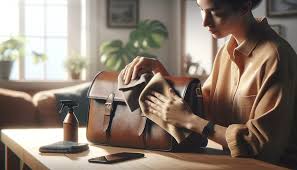How to Care for Your Leather Goods and Accessories
Keep your leather goods looking pristine with our essential guide to care and maintenance. From cleaning techniques to conditioning advice, discover how to preserve the beauty and extend the life of your leather accessories. Whether it’s a cherished handbag, a stylish belt, or a classic pair of shoes, these tips will help you keep your leather items in top condition and looking their best for years to come.
Ms. Jia
8/5/20243 min read


How to Care for Your Leather Goods and Accessories
Leather goods and accessories are timeless investments that can last for years with the proper care. Whether it’s a beloved leather handbag, a pair of stylish shoes, or a classic leather jacket, maintaining your leather items is essential to keep them looking pristine and ensure their longevity. Here’s a comprehensive guide on how to care for your leather goods and accessories, helping you to preserve their beauty and functionality for years to come.
Understanding Leather Types
Before diving into care tips, it’s important to recognize that not all leather is created equal. Different types of leather require different care approaches:
Full-Grain Leather: The highest quality, most durable type that ages beautifully. It requires regular conditioning to maintain its texture and prevent dryness.
Top-Grain Leather: Slightly lower quality than full-grain but still very durable. Often sanded and treated, it benefits from conditioning and cleaning.
Genuine Leather: The lower quality layer, more affordable, and often treated for a uniform appearance. It needs conditioning but is less durable than higher grades.
Suede and Nubuck: Soft, delicate leather types that are more prone to staining and require special care.
Essential Leather Care Tips
1. Regular Cleaning
Why: Regular cleaning removes dirt, oils, and contaminants that can damage leather over time.
How:
Dust Off: Use a soft, dry cloth or a soft-bristled brush to gently remove surface dust and dirt.
Wipe Down: For deeper cleaning, use a damp cloth with a mild soap solution (avoid harsh chemicals). Wipe the leather gently and then dry with a clean cloth.
Pro Tip: Test any cleaning solution on a small, inconspicuous area first to ensure it doesn’t discolor or damage the leather.
2. Conditioning Leather
Why: Conditioning helps to keep the leather supple, prevents cracking, and restores moisture lost through wear and environmental factors.
How:
Choose the Right Conditioner: Use a conditioner specifically designed for your type of leather. Apply a small amount to a cloth and gently rub it into the leather in circular motions.
Frequency: Condition your leather goods every 3-6 months, or more frequently for items that see heavy use or exposure to harsh conditions.
Pro Tip: Avoid over-conditioning, which can cause the leather to become too soft or oily.
3. Protecting Leather
Why: Protecting leather helps to prevent stains, water damage, and other types of wear.
How:
Waterproofing: Apply a waterproofing spray or cream to help protect against moisture. This is particularly important for leather shoes and bags.
Avoid Excess Moisture: Keep leather items away from water. If they do get wet, blot (don’t rub) the moisture with a dry cloth and let them air dry naturally.
Pro Tip: Avoid direct sunlight and heat sources that can cause the leather to dry out and crack.
4. Storing Leather Properly
Why: Proper storage prevents deformities, discoloration, and other damage.
How:
Keep Shape: Use tissue paper or shoe trees to help maintain the shape of leather bags and shoes.
Use Dust Bags: Store leather items in breathable dust bags to protect them from dust and scratches while allowing them to breathe.
Avoid Plastic: Don’t store leather in plastic bags, as they can trap moisture and cause mildew or mold.
Pro Tip: Hang leather jackets on padded hangers to maintain their shape and prevent creasing.
5. Dealing with Stains and Spills
Why: Prompt treatment of stains and spills can prevent long-term damage.
How:
Oil and Grease: Sprinkle a little talcum powder or cornstarch on the stain to absorb the oil, then brush off gently.
Ink Stains: Use a cotton swab dipped in rubbing alcohol and dab the stain lightly. Avoid scrubbing, which can spread the ink.
General Stains: Blot (don’t rub) the area with a damp cloth and a mild soap solution, then wipe clean and dry.
Pro Tip: Always test stain removal methods on an inconspicuous area first to ensure they don’t damage the leather.
6. Handling Special Leather Types
Suede and Nubuck:
Use a Brush: Use a suede brush to gently lift the nap and remove surface dirt.
Avoid Water: These leathers are particularly sensitive to water. Use a suede protector spray to guard against stains and moisture.
Patent Leather:
Wipe Clean: Use a damp cloth to wipe down patent leather, which is more resistant to stains and water.
Buff to Shine: Use a soft cloth to buff and restore the glossy finish.
Pro Tip: For persistent stains or damage, seek professional cleaning to avoid further harm to delicate leathers.
Conclusion
Caring for your leather goods and accessories doesn’t have to be a daunting task. With regular cleaning, conditioning, and proper storage, you can keep your leather items looking their best and extend their lifespan. By investing a little time and effort into maintaining your leather, you can enjoy the timeless elegance and durability that quality leather provides.
